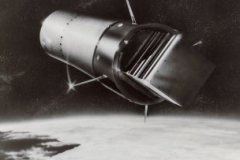Mercury Scout 1 (MS-1) was intended to conduct a test of the Mercury Tracking Network.
The plan was to launch a modified Scout rocket with a small communications satellite into orbit. The satellite would simulate a Mercury spacecraft, enabling testing and training with the Mercury Tracking Network.
The 67.5 kg MS-1 communications satellite was shaped like a small rectangular box. The electronics in the housing consisted of two radio receivers, two minitrack beacons, two telemetry transmitters, an S- and C-band beacon and antennas. All should be powered by a 1500 watt hour battery. Also included was the fourth stage instrument package. The battery could power the electronics for about 18 hours before running out. To extend the life of the satellite, the equipment would be shut down by a ground command after the first three orbits (5 hours). During power off, the data results would be analyzed. The satellite would then be powered for another three orbits (five more hours). This process would then be repeated a third time. Mercury planners assumed that by shutting down and powering up the satellite, the Mercury Tracking Network would receive data and experience from the equivalent of three Mercury orbital missions.
Mercury-Scout 1 was launched on November 1, 1961, at 15:32 UTC, from Launch Complex 18 (LC-18) at Cape Canaveral. The first stage of the Scout rocket exploded 26 seconds after launch. The other three stages were blown up shortly afterwards by the Range Safety Officer.
NASA has canceled further Mercury Scout missions. When Mercury-Scout 1 launched, the Mercury-Atlas 4 (MA-4) mission was already in orbit. Mercury-Atlas 5 (MA-5) followed Mercury-Scout 1 (MS-1) 28 days later. MA-4 and MA-5 verified the Mercury Tracking Network, eliminating the need for further Mercury Scout missions.
Mission data |
|
|---|---|
Mission |
Mercury-Scout 1 (MS-1) |
Rocket |
Blue Scout II |
Spacecraft |
Satellite MS-1 |
Launch date |
November 1, 1961 |
Launch site |
Launch Complex 18 (LC-18), Cape Canaveral, Florida |
Mission duration |
exploded shortly after launch |
Altitude |
– |
Distance |
– |
Velocity |
– |
Max G |
– |


